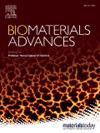Boosted breast cancer treatment with cell membrane-coated PLGA nanocarriers: Investigating the interactions with various cell types
IF 6
2区 医学
Q2 MATERIALS SCIENCE, BIOMATERIALS
Materials Science & Engineering C-Materials for Biological Applications
Pub Date : 2025-07-20
DOI:10.1016/j.bioadv.2025.214420
引用次数: 0
Abstract
Nanomaterials inspired by nature and applied in the medical field have exhibited remarkable potential to diagnose and treat diseases. However, further improvements are required to enhance therapeutic effectiveness, particularly in terms of targeting. In this study, we formulated paclitaxel (PTX)-loaded poly lactic-co-glycolic (PLGA) nanocarriers (PLGA-PTX NCs) and coated with cancer cell membrane derived from MCF-7 breast cancer cells, mPLGA-PTX NCs. By leveraging the homotypic adhesion between cells, we enhance the treatment's effectiveness, which is associated with increased accumulation of mPLGA NCs in MCF-7 cells. Additionally, the cellular uptake of mPLGA NCs is investigated in cell types similar to MCF-7, which may also promote homotypic adhesion through specific adhesion molecules. This study includes A549 lung cancer cells, HDFn dermal fibroblasts, and MCF-10A non-tumorigenic breast cells. Our results show higher uptake for all cell lines, indicating homologous binding and common cell adhesion molecules, regardless of specificity. The treatment's efficacy, as evidenced by cellular metabolic activity, implies that both the percentage of NC-positive cells and uptake levels should be considered when evaluating therapeutic potency. All findings together emphasize the importance of thorough analysis of nanocarrier-cell interactions covering various cell types and understanding the nature of these interactions.

用细胞膜包被的PLGA纳米载体增强乳腺癌治疗:研究与不同细胞类型的相互作用
纳米材料受到大自然的启发,并应用于医学领域,在疾病诊断和治疗方面显示出巨大的潜力。然而,需要进一步改进以提高治疗效果,特别是在靶向方面。在这项研究中,我们配制了紫杉醇(PTX)负载的聚乳酸-羟基乙酸(PLGA)纳米载体(PLGA-PTX NCs),并包被MCF-7乳腺癌细胞衍生的癌细胞膜,mPLGA-PTX NCs。通过利用细胞间的同型粘附,我们提高了治疗的有效性,这与MCF-7细胞中mPLGA NCs的积累增加有关。此外,在类似MCF-7的细胞类型中研究了mPLGA NCs的细胞摄取,mPLGA NCs也可能通过特异性粘附分子促进同型粘附。该研究包括A549肺癌细胞、hdf真皮成纤维细胞和MCF-10A非致瘤性乳腺细胞。我们的结果显示,所有细胞系都有较高的摄取,表明同源结合和共同的细胞粘附分子,无论特异性如何。细胞代谢活动证明了治疗的有效性,这意味着在评估治疗效力时应考虑nc阳性细胞的百分比和摄取水平。所有的发现都强调了深入分析纳米载体-细胞相互作用的重要性,这些相互作用涵盖了各种细胞类型,并理解了这些相互作用的本质。
本文章由计算机程序翻译,如有差异,请以英文原文为准。
求助全文
约1分钟内获得全文
求助全文
来源期刊
CiteScore
17.80
自引率
0.00%
发文量
501
审稿时长
27 days
期刊介绍:
Biomaterials Advances, previously known as Materials Science and Engineering: C-Materials for Biological Applications (P-ISSN: 0928-4931, E-ISSN: 1873-0191). Includes topics at the interface of the biomedical sciences and materials engineering. These topics include:
• Bioinspired and biomimetic materials for medical applications
• Materials of biological origin for medical applications
• Materials for "active" medical applications
• Self-assembling and self-healing materials for medical applications
• "Smart" (i.e., stimulus-response) materials for medical applications
• Ceramic, metallic, polymeric, and composite materials for medical applications
• Materials for in vivo sensing
• Materials for in vivo imaging
• Materials for delivery of pharmacologic agents and vaccines
• Novel approaches for characterizing and modeling materials for medical applications
Manuscripts on biological topics without a materials science component, or manuscripts on materials science without biological applications, will not be considered for publication in Materials Science and Engineering C. New submissions are first assessed for language, scope and originality (plagiarism check) and can be desk rejected before review if they need English language improvements, are out of scope or present excessive duplication with published sources.
Biomaterials Advances sits within Elsevier''s biomaterials science portfolio alongside Biomaterials, Materials Today Bio and Biomaterials and Biosystems. As part of the broader Materials Today family, Biomaterials Advances offers authors rigorous peer review, rapid decisions, and high visibility. We look forward to receiving your submissions!

 求助内容:
求助内容: 应助结果提醒方式:
应助结果提醒方式:


